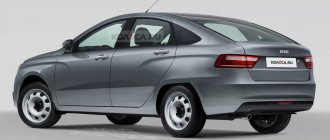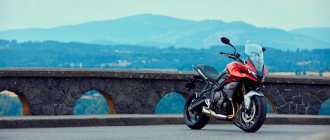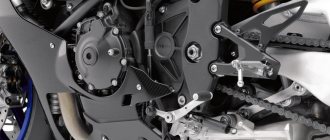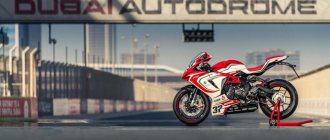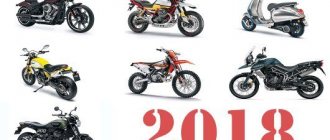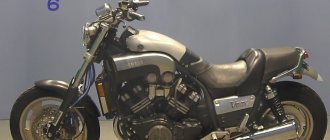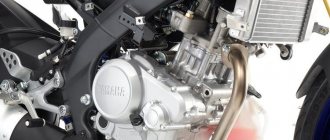Yamaha R7 2022
In 1998, the first YZF-R1 redefined sportsbikes, and since then Yamaha's R series has continued to evolve and expand, not only occupying, but also creating new niches in this field.
Today's R lineup, headlined by the flagship R1M—the most advanced production motorcycle Yamaha has ever built—offers road racing enthusiasts a superb selection of track bikes, including the R1 and R6 RACE, backed by a wide selection of tuning components from the GYTR catalog, allowing achieve even higher levels of engine and chassis performance. At the other end of Yamaha's sportbike spectrum, the twin-cylinder R3 and single-cylinder R125 are the perfect entry into the world of R-models for those new to motorcycling and track riding in particular. The world of motorsports is changing, and while extreme models are in demand among discerning motorcyclists, Yamaha continues to expand its sports line by adding the R7 model, which will help new riders enter the GCMG.
Yamaha R7: with respect to the legend
There is no motorcycle that can be compared to the original Yamaha YZF-R7. This factory race bike could hardly be called a production bike: it was produced in an edition of 500 copies, mainly to qualify it for World Superbike and Suzuka 8 Hours. Ridden by motorsport legends including Noriyuki Haga and Akira Yanagawa, the Yamaha YZF-R7 was considered one of the most exotic and desirable Japanese motorcycles to ever go into production. The new R7 is named after the legend to pay tribute to the original superbike. The 2022 Yamaha R7, proudly bearing the legendary name, is a new breed of sportbike designed for a young audience and designed to attract young riders to the joy of owning and riding a motorcycle of the legendary series.
Specifications
Yamaha R7 (YZF-R7) Specifications:
| Model | Yamaha YZF-R7 |
| Motorcycle type | sport |
| Year of issue | 1999 |
| Frame | aluminum Deltabox II |
| engine's type | 4-cylinder, 4-stroke, in-line |
| Working volume | 749 cm³ |
| Bore/Stroke | 72.0 x 46.0 mm |
| Compression ratio | 11,4:1 |
| Cooling | liquid |
| Number of valves per cylinder | DOHC, 5 valves per cylinder |
| Fuel supply system | injector with dual butterfly valves, 4x 46 mm |
| Ignition type | CDI |
| Maximum power | 106.0 hp (78.0 kW) at 11000 rpm - standard power 137.0 hp (100.7 kW) – race-kit I 164.0 hp (120.8 kW) – race-kit II |
| Maximum torque | 72.0 Nm (7.3 kg*m) at 9000 rpm - standard torque |
| Clutch | Multi-disc in oil bath, hydraulic drive |
| Transmission | 6-speed |
| type of drive | chain |
| Front tire size | 120/70 ZR17 (58W) |
| Rear tire size | 180/55 ZR17 (73W) |
| Front brakes | 2 discs 320 mm, 4-piston calipers |
| Rear brakes | 1 disc 245 mm, 2-piston caliper |
| Front suspension | 43 mm Öhlins inverted telescopic fork (all adjustments), travel - 120 mm |
| Rear suspension | pendulum with Öhlins monoshock absorber (all adjustments), stroke - 138 mm |
| Length | 2060 mm |
| Width | 720 mm |
| Height | 1125 mm |
| Wheelbase | 1400 mm |
| Seat height | 840 mm |
| Minimum ground clearance (clearance) | 120 mm |
| Acceleration 0-100 km/h (0-60 mph) | 3.4 sec[1] |
| Maximum speed | 273 km/h[2] |
| Gas tank capacity | 23.0 l (including reserve - 4.8 l) |
| Motorcycle weight (curb) | 207 kg |
The world of racing becomes more accessible with the Yamaha R7
The arrival of the new Yamaha R7 makes the world of racing more accessible to many young riders who have discovered a penchant for sportbikes. Based on the incredibly successful and beloved CP2 engine, renowned for its strong linear thrust, reliability and low maintenance costs, this engine is wrapped in a carefully and tastefully engineered hood and fitted with high-quality chassis components, including radial front calipers and a turbocharger. , inverted forks and light-slip slipper clutch, the R7 is a new type of motorcycle that combines the superb performance, superb handling and chic design of the R series with a very competitive price.
Lightweight, compact and nimble, the chic new Yamaha R7 is designed to give riders the highest level of control and maximum wow factor in its class, whether on the track or on the road. But the main thing is that this sportbike is truly accessible to any rider who wants to enter the world of R-series sportbikes. The Yamaha R7 is a new reality and is poised to attract new audiences and influence the sportbike world.
Yamaha R7
Review of the new 2022 Yamaha YZF-R7
The Tuning Fork brand is completing its latest addition to the supersport motorcycle segment with the introduction of the new 2022 Yamaha YZF-R7, priced at $8,999. The R7 replaces the R6 on paper, but not in spirit. The R6 has been discontinued for the 2021 model year, citing low sales volumes due in part to its high cost ($12,199).
The Yamaha 1999 YZF-R7 is powered by a proven 689cc liquid-cooled twin-cylinder engine. see Based on the current MT-07 naked bike, the R7 is not intended for competition. Instead, it's suitable for general street riding and casual track days. The power plant has a power of 67 hp. and torque of 46 lb.-lb. It also boasts a slipper clutch that helps reduce rear wheel instability when downshifting for vehicle speed.
Yamaha also offers the GYTR electronic quickshifter as an original accessory. This allows clutchless upshifts through the six-speed gearbox. This model lacks traction control and variable engine power/throttle.
The engine is bolted inside a reinforced steel frame (directly, without rubber mounts), the geometry of which is different from the dimensions of the MT-07. Aluminum plates on either side of the swingarm axis increase rigidity.
Suspension consists of three-way adjustable KYB inverted forks and an adjustable horizontally mounted linkage shock with adjustable preload and rebound damping. Both provide just over 5 inches of wheel travel. Seat height is increased by an inch and the saddle is a thicker version of the R6. This improves comfort on long street trips.
Radial-mount front disc brakes control speed with the help of a larger rear disc brake. The system is complemented by a Brembo radial front master cylinder. Fixed, always-on ABS eliminates tire lockup if you apply any brake too hard.
In terms of styling, the R7 benefits from Yamaha's signature R styling. Riders will appreciate the YZR-M1's fishgills over the 3.4-gallon fuel tank and its sleek bodywork, reminiscent of the outgoing R6. LED lighting is another nice touch. A negative-lit instrument panel (black background with white numbers) allows you to monitor vehicle settings.
2022 Yamaha YZF-R7 specifications
Engine: 689 cc, two-cylinder, liquid cooled; 4 valves/cylinder.
Bore x stroke: 80.0 x 68.6 mm
Compression ratio: 11.5:1
Fuel Delivery: Fuel Injection
Clutch: wet, multi-disc slipper/assist
Transmission/final drive: 6-speed/chain
Frame: steel lattice
Front Suspension: 41mm KYB inverted forks, preload, compression, rebound adjustable; 5.1" travel
Rear Suspension: Single shock, preload and rebound damping adjustable, 5.1 inches of travel
Front brakes: 298 mm discs with ABS
Rear brake: 245 mm disc with ABS
Wheels, front/rear: cast aluminum
Tires, front/rear: Bridgestone Battlax S22; 120 / 70-17 / 180 / 55-17
Seat Height: 32.9 inches
Fuel tank capacity: 3.4 gallons.
Claimed wet weight: 414 lbs.
Warranty: 1 year limited factory warranty.
Available: June 2021
Tips for a beginner motorcyclist || Yamaha has announced an updated Zuma 125 scooter
Related posts:
Yamaha XSR900 motorcycle reviewIn the section: Moto newsThe Yamaha XSR900 is a standard modern motorcycle that would be most suitable for city riding. | Yamaha R6 will remain a 4-cylinderIn the section: Moto newsRumors that Yamaha will begin production of a 3-cylinder motorcycle have been completely refuted. |
Zontes will release an 800cc naked bike in 2022In the section: Moto newsZontes has warned of preparations for the appearance on the market of an 800 cc naked bike that could surprise Europe and compete with already established brands. | There will be no motorcycle exhibition Intermot 2021 in CologneIn the section: Moto newsIntermot 2021 has been cancelled. Manufacturers are holding their presentations online to compensate for the lack of a motorcycle show. |
Review and technical specifications of the new product from Polaris - the 2022 RZR RS1 ATVIn the section: ATV newsReview and technical specifications of the 2022 Polaris RZR RS1 ATV | New 2022 Can-Am Maverick Trail DPS 1000 ATVIn the section: News, articlesNew 2022 Can-Am Maverick Trail DPS 1000 ATV Review |
Yamaha R7 engine
Considering the R7's mission to be accessible and fun, its 689cc CP2 engine is an excellent and well-justified solution. It's been hailed as one of the most characterful, responsive and reliable designs in the class, and it forms the perfect basis for the new model. The CP2 four-stroke inline twin features a 270-degree crankshaft with an unusual firing pattern, dual overhead camshafts and four valves, and a liquid cooling system. It produces powerful, linear thrust over a wide range of rotational speeds, and responds perfectly to the throttle in any gear and at any speed. Peak power of 73.4 hp is achieved at 8750 rpm, and peak torque of 67 Nm occurs at 6500 rpm, giving the Yamaha R7 extremely powerful acceleration both from the start and at high revs, and the unusual rhythm of the 270-degree crankshaft determines unsurpassed pleasure from increasing rotation speed. ECU firmware was created especially for the R7, as well as the intake was optimized, the exhaust tract was improved and the fuel injection system was perfectly tuned. These measures improve handling and result in a smooth but lively throttle response, making the R7 a pleasure to drive no matter the pace, while ensuring compliance with Euro 5 regulations. In addition to these modifications, the R7 received a slightly revised gearbox with a shorter second gear for a sportier character. and powerful acceleration.
Dimensions and weight
The weight of this car is 176 kg, not including fuel. The gas tank volume here is very large for the sports class and is 23 liters. The saddle height is significant: 840 mm. Wheelbase dimensions – 1400 mm. In general, the motorcycle can hardly be called small or, on the contrary, large.
Yamaha R7 clutch
The Yamaha R7's superior handling is enhanced by a new light-slip slipper clutch , which allows for smoother shifts and prevents over-revving the engine and stalling the rear wheel under heavy braking and downshifts, resulting in more predictable and controlled handling in corners. Another benefit of the new clutch is that the lever pull is significantly lighter, approximately 33 percent lighter than a standard clutch.
Quickshifter
Yamaha R7 owners can equip it with a quickshifter, available as an option at Yamaha dealers. This simple but effective device is a limit switch located on the gear shift rod and determines the shift point. When the shift lever is moved up, the ECU relieves power from the transmission for a few milliseconds, allowing for faster, smoother upshifts at full throttle and even more powerful acceleration.
Yamaha R7 chassis
The compactness and lightness of the Yamaha R7 is ensured by a lightweight spine frame designed for excellent handling and ease of steering. A rigidly mounted aluminum center brace improves handling both on the track and on the road, while the high-strength steel frame uses variable-stiffness tubing in key locations to provide the perfect balance of rigidity.
Fork
Careful attention has been paid to the Yamaha R7's suspension, resulting in excellent fork feedback during cornering and braking, along with stability and excellent grip on the track and twisty roads. Clear and predictable feedback is provided by the upper yoke, made using gravity casting technology, and the lower one, forged. The R7 can be easily customized to suit rider needs and riding conditions, with its inverted 41-split fork featuring spring preload, compression and rebound damping adjusters. At the same time, the left fork leg smoothes out compression, and the right one smoothes out rebound, making adjustments simple and informative. The steering precision and crisp feedback of the R7 fork provide a steep 23.7-degree head angle and 90mm trail, and with a compact 1395mm wheelbase and excellent weight distribution (51 percent of the weight is on the front wheel), the new sportbike is designed for fast and precise performance. turns.
Rear suspension
The Yamaha R7 features a redesigned Monocross linkage suspension with damping characteristics and spring rates designed specifically for the sporty nature of the bike. The shock's horizontal mounting provides optimal weight distribution, and the shock itself has spring preload and rebound damping adjustments, allowing you to tune the R7's chassis to suit your riding conditions.
Official: New Yamaha YZF-R7 sportbike - why it is, photos, description and characteristics
The new mid-sized sportbike Yamaha YZF-R7 (YZF700R7) has been officially presented: why is it needed, how does Yamaha see its place in the world of motorsports and what technologies are used in it?
MOTOGONKI.RU, May 18, 2021 — So, the success story of Yamaha in world motorsports began a long time ago, as soon as the Japanese decided to enter the fray for the Moto Grand Prix. But, as then and now, prototypes do not drive on roads and streets. But there are numerous sport tourists created on the basis of sport bikes and sport bikes themselves.
Why R7?
Yamaha's success story in production motorcycle circuit racing began in January 1998 with the introduction of the first YZR-R1, the ultimate superbike with a 999cc inline-four, rigid Deltabox frame, motorsport suspension and brakes, and a shrimp-like riding position. And the next year after the debut of the R1, the YZF-R7 was released - a unique, almost prototype superbike, specially created by Yamaha for World Superbike racing. It was equipped with a 750 cc engine to meet the technical requirements of the FIM of that period. To fall under the definition of a serial motorcycle, Yamaha produced 500 of these machines - exactly as many as needed and not one more.
Legendary Yamaha YZR-R7 1999
Despite producing only 106 hp, the YZF-R7 reached speeds of 262 km/h and easily competed with its rivals in racing. The real performance of the R7 with the prepared engine was, of course, slightly higher than 106 hp... Was it the best bike in the paddock? Hard to say. At the same time, the R7 immediately became a legend... and was gone forever. But the name and some vivid memories remained.
Read more: The legendary Yamaha R7 will return - history and facts
The R-series has changed a lot since then. The R7 sank into oblivion along with the World Superbike regulations, its place was soon - and to this day - taken by the R1. And when the Supersport class, created specifically for 600 cc motorcycles, appeared, Yamaha created the YZF-R6. Years passed, the trend changed, and a 300 cc “R” appeared - the YZF-R3 for the Supersport 300.
Yamaha YZF-R7 (2021) - review and specifications
If the 1999 Yamaha YZF-R7 was based on the chassis and many technologies of the MotoGP prototype - the Yamaha YZR500, and the engine was inherited from the YZF750, then the YZF-R1 and R6 were based on the development of the new generation MotoGP prototype - the YZR-M1. The new R7 is based on a street motorcycle chassis, although it uses a number of thoroughbred, purely sporting components.
And yet the R7 is not a Supersport
But today the Supersport class is changing rapidly.
600 cc in-line engines are no longer relevant because they do not meet environmental standards and have been removed from the lineup of almost all manufacturers. Their place should be taken by either 3-cylinder engines up to 765 cc, or 2-cylinder engines up to 890 cc. The liter class is still struggling for a place in the sun, but it is a fact that in World Superbike there are trends to increase engine sizes in order to reduce emissions while maintaining performance.
Yamaha YZF-R7 (2021) - review and specifications
This is exactly what Yamaha is talking about: “the nature of Supersport is changing before our eyes, and companies are forced to change development concepts”
.
Therefore, the new R7, both at first and second glance, does not look sporty at all. Yamaha emphasizes that the YZF-R7 is a motorcycle primarily focused on road use, less on the track... not what everyone expected? Yes, but this is the future.
Who is it for?
So, the Yamaha YZF-R7 is created for the younger generation of riders
who want to drive actively and often, but not in a “three hundred” or a “liter”, while regularly visiting amateur track days.
Previously, the Iwata plant managed to create a similar universal device: a test drive of the 2021 Yamaha YZF-R1
.
Yamaha YZF-R7 (2021) - review and specifications
The R7 won't be a real replacement for the R6 - it's not a radical sportbike that will make everything hurt at first. It has the attributes of a sportbike, but is still intended for roads.
Yamaha YZF-R7 (2021) is focused on public roads, less on the track
What is inside?
At the center of the design is a 689 cc CP2 inline 2-cylinder engine equipped with an A&S clutch. The 4-valve DOHC engine with a 270-degree crankshaft should produce a modest 73.4 hp in the base version. at 8750 rpm, torque 67 Nm at 6500 rpm, which in terms of performance is no different from the MT-07 road bike with the same engine. But in America there is an incredible amount of racing tuning for CP2
- from redesigned heads to forged pistons and more - everything to increase power by 12-15 hp.
But engine performance in absolute terms, according to Yamaha, should not rest on peak power: acceleration dynamics and power delivery to the wheel are the key points of the new sportbike
And Yamaha took into account a number of basic wishes. The engine, although similar to the CP2 from the MT-07, actually received a number of changes. It has a different exhaust chamber, a different exhaust system, different injectors, a completely different intake as a whole, a different control unit (ECU), different firmware, different power and ignition maps, and completely different operating strategies for the control and auxiliary electronics.
Yamaha YZF-R7 (2021) is focused on public roads, less on the track
The A&S type clutch (assisting, slipper) provides up to 33% easier operation of the mechanism and less pressure on the lever. At the same time, it gives better response when braking by the engine (and harder braking in itself). Quick Shifter (QSS) will come as an additional option, but all the control that is required is already included in the Yamaha R7 electronics.
Yamaha YZF-R7 (2021) is focused on public roads, less on the track
Handling and controllability are at the forefront of the new R7. A lightweight steel backbone frame with aluminum crossbars will provide good feedback to the asphalt when changing direction. The chassis is equipped with a 41 mm KYB upside-down fork with a full range of adjustments. But the functions of the pens are divided: on the left there is a cartridge responsible for compression; in the right - for the release. The rear shock is mounted via Monocross's signature progressive linkage. The spring rate and basic setting are geared towards sports use.
Super-controllable
The chassis geometry is aimed at almost equal wheel loading (in a ratio of 51% to 49%). The inverted fork provides a fairly steep caster of 23.7 degrees with a 90mm offset. The wheelbase is 1395 mm, very short: to be nimble.
Yamaha YZF-R7 (2021) - review and specifications
What makes the bike track ready are the high stopping power 4-piston radials from Brembo and a curb weight of just 188kg. Lightweight aluminum wheels for 120/70ZR17 and 180/55ZR17 tires.
Yamaha YZF-R7 (2021) - review and specifications
The motorcycle is also equipped with clip-ons as standard. The driving position is much sportier than that of sports tourists. At the same time, Yamaha has left enough space in the saddle so that any rider can sit comfortably there. The footpegs are mounted high enough, in a sporty manner, for optimal weight distribution and control. The set of Yamaha branded accessories already includes a cover to replace the passenger seat, which here looks like a completely unnecessary element.
Yamaha YZF-R7 (2021) - review and specifications
The design of the fairings, according to Yamaha, migrated straight from MotoGP. There is an M-shaped air intake like the prototype. LED headlights are recessed into peculiar niches. The road version has an LCD control panel, but when the motorcycle is converted to a track version, it will be replaced with a more advanced one with a 2D data logger, etc., with a 100% guarantee.
What is the price?
Delivery of the motorcycles in Europe will begin in October 2021. In Russia, in theory, they can be expected in the spring of next year. The price tag for Russia has not yet been announced. But in the US, MSRP has already been announced - it is $8999 for the basic version.
Yamaha YZF-R7 (2021) - review and specifications
Colors: blue and black, as in the photos. But there will also be a Yamaha Yellow Racing Special (or something in this direction) - a traditional yellow and black Yamaha in the MotoGP style of previous years, for connoisseurs.
Landing
The Yamaha R7's sporty riding position is the result of hours of testing by factory team riders, and the clip-ons confirm the model's racing origins. After extensive experimentation with a wide variety of handlebar/seat/peg configurations, the final design was chosen to provide a sporty yet adaptable riding position that allows the body to move freely in a variety of situations, especially on the track and on twisty roads. An important feature is the design of the seat: it tapers at the rider's inner thighs and widens at the rear, providing maximum freedom of movement. The clip-on configuration and position of the footpegs have been carefully thought out to provide a collected riding position for optimal handling and maximum aerodynamic efficiency. The possibility of a tight fit is enhanced by the deeply concave shape of the tank, which allows you to hold on with your knees when braking and turning. The single driver's seat has a step, and on top of the tail there is a passenger section, which can be covered with an optional tail fairing, available from the accessories catalogue.
Dimensions
What makes the Yamaha R7 extremely attractive is that it provides the highest level of handling and control in a variety of situations. The key factor in connecting rider and motorcycle is its compact size, allowing full control. With a curb weight of 188kg and compact proportions, the motorcycle allows even the shortest and most compact riders to handle it, and thanks to its excellent weight distribution, low front end and low moment of inertia, the rider feels full control over the motorcycle, allowing him to improve his skills and gain maximum confidence when riding.
Body kit
The key to high speed and controllability of any sportbike is maximum aerodynamic efficiency. To achieve this, the front end of the motorcycle must be as compact as possible, and this is where the R7 has a powerful advantage. The CP2 engine is one of the most compact in the 700 cc class, and the minimalist tubular steel chassis makes the Yamaha R7 one of the narrowest in the R range - even narrower than the R3 and R125, and therefore extremely aerodynamically efficient, including with a rider in the saddle. As a result, the incredibly compact front end gives the R7 an impressive appearance while making the most of the engine's resources, making the R7 the fastest model yet powered by the same engine.
Chassis and brakes
The braking system of this model is excellent: there is one 245 mm disc at the rear of the motorcycle and a pair of 320 mm at the front. The rear suspension is pendulum, while the front has an inverted fork with a travel of 120 mm. All this is enough to make the rider feel great, both at low speeds and at high speeds.
A few words should be said about the exterior: this is a bright, impressive and stylish motorcycle, the embodiment of technology and taste. It seems to be imbued with modernity, reflected in every detail of its appearance.
Yamaha R7 dashboard
Yamaha R7 dashboard
The compact ergonomics of the sportbike results in a light and small instrument panel with inverse LCD indicators. The panel is perfectly organized, and its readings are perfectly perceived at one glance, which means it does not distract the rider and allows him to concentrate on riding. Among other things, the panel displays a gear indicator, a gear shift prompt, and a quickshifter indicator if equipped.
History of changes
Like many bikes that are produced in limited numbers for a short period of time, the YZF R7 has not received any updates. Perhaps in conclusion it is worth emphasizing its main features:
- advanced technologies for its time;
- huge difference with other bikes;
- high cost as a consequence of innovation.
The YZF R7 may not have received the popularity it deserved, but it will forever go down in the history of motorcycle construction as one of the most outstanding examples.
Technical features of Yamaha R7
- Compact, high-torque 689 cc CP2 engine with cross-shaped crankshaft
- Euro 5 Compliant
- Ultra-compact design
- Aerodynamic hood with aluminum lower part
- High quality inverted 41st fork
- Link rear suspension with new shock absorber
- Light slipper clutch
- Lightweight tubular steel frame with aluminum center brace for rated chassis rigidity
- Rear clip-ons and footrests
- Sporty fit
- Aggressive R-Series design with two LED running lights
- Powerful central LED headlight
- Light alloy 10-spoke wheels
- Radial front calipers with Brembo radial master cylinder
- Sporty ergonomics with LCD instrument panel
- Central M-shaped air intake
- Compact, sculpted 13-litre fuel tank
- Tires size 120/70 front and 180/55 rear
Yamaha R7 colors
The new R7 is available in two color options, which debut the updated design of the entire R series. The first color option is Icon Blue on the upper body elements, lower aluminum panels and wheels, while the sides of the fairing are painted in a contrasting darker matte blue. The engine, some trim elements and the swingarm are painted in Crystal Graphite, emphasizing the power and dynamism of the R7.
The R7 will also be available in Yamaha Black with minimalist graphics and accents. The gloss black finish gives the bike a distinctive sporty look, which is enhanced by the Crystal Graphite paint job on the engine and chassis. The beauty of this simple colorway is that it looks chic with a variety of outfits, highlighting them without distracting from them.
The Yamaha YZF-R7 is a little-known motorcycle, mainly due to the fact that it was released in a very, very modest edition - only 500 pieces, in 1999-2000. Moreover, at the time of sale, for the price of the R7, you could buy two new Yamaha YZF-R1, which was Yamaha’s flagship in the sports motorcycle segment. This was due to the fact that in the production of the YZF-R7 all the most advanced technologies available to the manufacturer at that time were used.
This motorcycle was produced in such a small series for rather unusual reasons. The fact is that the Yamaha YZF-R7 was developed specifically for participation in world competitions, in which only mass-produced models were allowed to participate. Thus, the company decided to produce and sell 500 copies of the motorcycle, which ensured its small-scale status and gave it the right to participate in racing. From a technical point of view, the YZF-R7 was close to perfection, which was the reason for its sky-high price. Alas, it is unlikely that anyone reading this article will ever see the R7 in person, except perhaps in some museum...
A 749 cc forced engine was installed in the aluminum frame of the Yamaha YZF-R7, the connecting rods and valves of which were made of titanium alloy, with 5 valves for each of the four cylinders. The injector was responsible for supplying fuel. Engine power was artificially limited due to the maximum power requirements imposed by some countries, but the YZF-R7 had enormous "throttle" potential. In factory condition the motorcycle has 106 hp. and 72 Nm of torque, but by turning on additional injectors (disabled from the factory), the power could be increased to 139 hp, and installing a special racing kit increased it to 162 hp.
In total, the maximum speed of the Yamaha YZF-R7 is 280 km/h, and from 0 to 100 km/h this motorcycle accelerates in about 4 seconds. At the same time, the dry weight of the bike is only 176 hp, partly thanks to the aluminum frame and lightweight aluminum fuel tank, which, by the way, has a respectable volume of as much as 23 liters. Driving performance is ensured by suspensions (upside-down fork and monoshock) manufactured by Öhlins, which boast a full range of various adjustments. The brakes of the YZF-R7 also matched its tireless agility - two 320 mm discs with 4-piston calipers at the front and a 245 mm disc with a 2-piston caliper at the rear.
The low popularity of this model is due, first of all, to the very small edition in which it was released. If the Yamaha YZF-R7 had been mass-produced, it would certainly have gained wild popularity along with the Yamaha YZF-R6 and the aforementioned YZF-R1. In addition, large-scale production would certainly help reduce the price and keep it at an acceptable level. Alas, all the R7s that were produced and survived since then are now stored in museums and private collections.
Similar articles:
- Yamaha FZR 600 Review
- Yamaha YZF R3 Review
- Kawasaki GPZ 500 review
- Yamaha FZ-1 Review
- Yamaha FZ 750 Review
- Yamaha FJ-09 Review
LiveJournal
Options and Accessories
The Yamaha Genuine Accessories catalog consists of an ever-expanding list of tuning, protection and aesthetic options designed for both the track and the road. The performance-focused track line includes an Akrapovic titanium exhaust, quickshifter, milled engine covers, and engine and radiator guards. Options for the road include a smaller license plate holder, LED turn signals, a tank trim, and a variety of milled elements, including engine protection.
The Paddock Blue clothing catalog consists of casual clothing in Yamaha style and certified safety equipment.
MyGarage app
Yamaha's MyGarage App is a quick way to build a virtual R7 in your choice of colors and accessories on your smartphone or PC. The app allows you to configure your ideal R7, and the result can be viewed from all angles in a 3D view. MyGarage will tell you what accessories are available and help you select them, and can also send a letter to the Yamaha dealership and place an order to retrofit the motorcycle with the selected options and accessories (in the Russian Federation, of course, this is doubtful).



